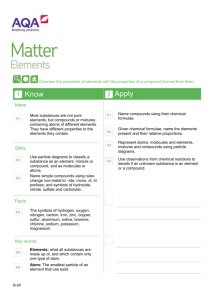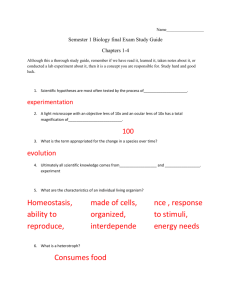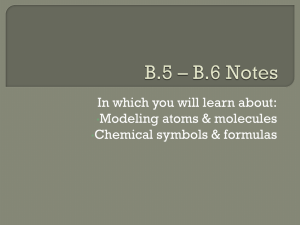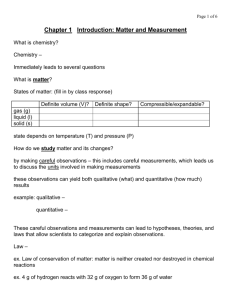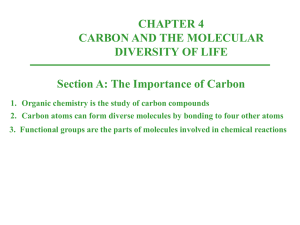What is Organic Chemistry? - Westgate Mennonite Collegiate
advertisement
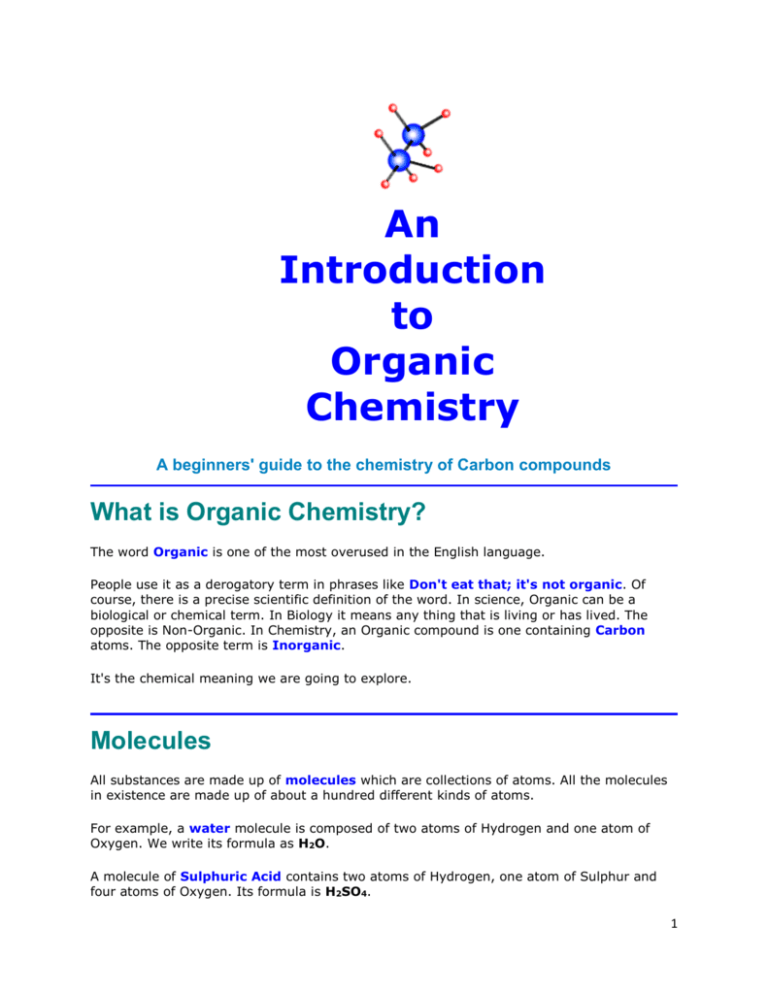
An Introduction to Organic Chemistry A beginners' guide to the chemistry of Carbon compounds What is Organic Chemistry? The word Organic is one of the most overused in the English language. People use it as a derogatory term in phrases like Don't eat that; it's not organic. Of course, there is a precise scientific definition of the word. In science, Organic can be a biological or chemical term. In Biology it means any thing that is living or has lived. The opposite is Non-Organic. In Chemistry, an Organic compound is one containing Carbon atoms. The opposite term is Inorganic. It's the chemical meaning we are going to explore. Molecules All substances are made up of molecules which are collections of atoms. All the molecules in existence are made up of about a hundred different kinds of atoms. For example, a water molecule is composed of two atoms of Hydrogen and one atom of Oxygen. We write its formula as H2O. A molecule of Sulphuric Acid contains two atoms of Hydrogen, one atom of Sulphur and four atoms of Oxygen. Its formula is H2SO4. 1 These are simple molecules containing only a few atoms. Most Inorganic molecules are small. Below are a few common inorganic substances with their formulas. Name of Substance Formula Carbon Dioxide CO2 Salt NaCl Nitric Acid HNO3 Laughing Gas N2O Ammonia NH3 Saltpetre (used in gunpowder) Carbon Monoxide KNO3 CO Potassium Permanganate (used in labs) KMnO4 Calcium Carbonate (chalk) CaCO3 All of these molecules have less than a dozen atoms. The symbols Ca, K, Mn, Na and Cl stand for calcium, potassium, manganese, sodium and chlorine. Molecules With Carbon Most atoms are only capable of forming small molecules. However one or two can form larger molecules. By far and away the best atom for making large molecules with is carbon. Carbon can make molecules that have tens, hundreds, thousands even millions of atoms! The huge number of possible combinations means that there are more carbon compounds that those of all the other elements put together! A single carbon atom is capable of combining with up to four other atoms. We say it has a valency of 4. Sometimes a carbon atom will combine with fewer atoms. The carbon atom is one of the few that will combine with itself. In other words carbon combines with other carbon atoms. This means that carbon atoms can form chains and rings onto which other atoms can be attached. This leads to a huge number of different compounds. Organic Chemistry is essentially the chemistry of carbon. Biochemistry is a branch of organic chemistry. 2 Carbon forms four bonds with other atoms (each bond consisting of one of carbon's electrons and one of the bonding atom's electrons). Every valence electron participates in bonding, thus a carbon atom's bonds will be distributed evenly over the atom's surface. These bonds form a tetrahedron (a pyramid with a spike at the top), as illustrated below: Carbon forms 4 bonds Questions to check understanding: 1. What is the difference between organic and inorganic chemistry? 2. Why can organic molecules be so much larger than inorganic molecules? 3. Why carbon so good at making large molecules? 4. What is the basic shape of a single carbon-based compound? 3 Classifying Organic Hydrocarbon Compounds Organic (carbon-based) compounds are classified according to how the carbon atoms are arranged and what other groups of atoms are attached. Hydrocarbons The simplest Organic compounds are made up of only Carbon and Hydrogen atoms only. Even these run into thousands! Compounds of Carbon and Hydrogen only are called Hydrocarbons. Please note that the molecule structure images below show the structure of three dimensional molecules in two dimensional format. Alkanes The simplest Hydrocarbon is methane, CH4. This is the simplest member of a series of hydrocarbons. Each successive member of the series has one more Carbon atom than the preceeding member. This is shown in the table below. Make ethane and propane, butane and pentane with your molecular modeling kits and draw the molecules in the chart below. (You may need to combine several kits to make the larger molecules.) Formula Structure Name / Uses CH4 Methane - gas used for cooking. C2H6 Ethane C3H8 Propane - heating fuel. 3-D Shape 4 C4H10 Butane lighter / camping fuel. C5H12 Pentane C6H14 Hexane There is a series of these compounds with this general formula: CnH2n+2 This series of compounds are called alkanes. The lighter ones are gases and used as fuels. The middle ones (7 Carbons to 12 Carbons) are liquids used in petrol (gasoline). The higher ones are waxy solids. Candle wax is a mixture of alkanes. After Butane, the names of these compounds are from the Greek for the number of Carbon atoms followed by the suffix -ane. So, Decane would have the formula C10H22. In the alkanes, all four of the Carbon valency bonds are taken up with links to different atoms. These types of bonds are called single bonds and are generally stable and resistant to attack by other chemicals. Alkanes contain the maximum number of Hydrogen atoms possible. They are said to be saturated. (This connects to saturated fats – their long carbon chains have only single bonds and are saturated with hydrogen atoms.) 5 Alkane Naming Basics: Carbon Atoms Prefix Alkane Chemical Structural Name Formula Formula 1 Meth Methane CH 4 CH4 2 Eth Ethane C2H6 CH3CH3 3 Prop Propane C3H8 CH3CH2CH3 4 But Butane C4H10 CH3CH2CH2CH3 5 Pent Pentane C5H12 CH3CH2CH2CH2CH3 6 Hex Hexane C6H14 ... 7 Hept Heptane C7H16 8 Oct Octane C8H18 9 Non Nonane C9H20 10 Dec Decane C10H22 The alkanes are not the only hydrocarbons. 6 Alkenes Another series of compounds is called the alkenes. These have a general formula: CnH2n. Alkenes have fewer hydrogen atoms than the alkanes. The extra valencies left over occur as double bonds between a pair of Carbon atoms. The double bonds are more reactive than single bonds making the alkenes chemically more reactive. The simplest alkenes are listed in the table below. Make propene, butane, and pentene with your molecular modeling kits and draw the molecules in the chart below. (You may need to combine several kits to make the larger molecules.) Formula Structure Name / Uses C2H4 Ethene - used as an industrial starter chemical. C3H6 Propene C4H8 Butene C5H10 Pentene 3-D Shape These compounds are named in a similar manner to the alkanes except that the suffix is ene. 7 Alkynes A third series are the alkynes. These have the following formula: CnH2n-2. Alkynes have two carbon atoms joined by a triple bond. This is highly reactive making these compounds unstable. Single Bonding (alkanes) Double-bonding (alkenes) Triple-bonding (alkynes) Examples of alkynes are: Formula Structure Name / Uses C2H2 Ethyne - better known as acetylene which is used for welding underwater. C3H4 Propyne C4H6 Butyne C5H8 Pentyne These highly reactive substances have many industrial uses. Again the naming of these compounds is similar to the alkanes except that the suffix is yne. 8 Carbon Rings Alkanes, alkenes and alkynes all contain Carbon atoms in linear chains. There are also hydrocarbons arranged in rings. Some examples follow: Formula C6H12 Structure Name / Uses Cyclohexane - a saturated hydrocarbon with the atoms arranged in a hexagonal ring. In organic chemistry, the presence of Hydrogen atoms is often assumed and this compund can be reprsented by a hexagonal ring: Benzene - an industrial solvent. C6H6 The Benzene Ring is one of the most important structures in organic chemistry. In reality, its alternate double and single bonds are "spread around" the ring so that the molecule is symetrical. This structure is represented by a hexagon with a circle: Toluene - an important solvent and starter chemical. Using the Benzene Ring, this molecule can also be depicted as: C7H8 9 Naphthalene - used in moth balls. C10H8 This can be depicted as two fused Benzene Rings: When rings are combined with chains, the number of hydrocarbons is virtually infinite. And we are still using only two types of atoms (Carbon and Hydrogen). We will now add a third. Questions to check understanding: 1. What two atoms are basic organic molecules made of? 2. Draw ethane, ethane and ethyne in 3-D. 3. What is the difference between alkanes, alkenes, and alkynes? 4. Which cyclical hydrocarbon is the most important in organic chemistry? Why? 5. Use the attached sheet to make flashcards to help you learn/study. 10 Saturated hydrocarbon CnH2n+2 e.g. CH3CH3 (i.e. C2H6 , where 2n+2 = 2(2) + 2 = 6) Alkene Alkyne Butene 11 12 Ethane CH3(CH2)4CH3 or C6H14 Propene Ethyne 13 14 C10H22 Organic molecule made of only carbon and hydrogen Carbon molecule Valency = 4 tetrahedral shape 15 16 Adding Functional Groups to Hydrocarbon Building Blocks Carbon, Hydrogen and Oxygen When Oxygen atoms are added, the variety of compounds grows enormously. In the table below, each row discusses a series of compounds. General Formula Series Name CnH2n+1OH Alcohols Details Examples Alcohols have the OH (hydroxyl) group in the molecule. CH3OH Methanol wood alcohol A group of atoms that gives an organic series its distinctive character is called a functional group. Structures C2H5OH Ethanol drinking alcohol C6H5OH Phenol carbolic acid used as disinfectant (CnH2n+1)2O Ethers (CH3)2O Dimethyl Ethers have Ether an O atom a gas attached to two (C2H5)2O hydrocarbo Diethyl Ether n chains (or a liquid used rings). as an anaesthetic) (CnH2n+1)2C Ketones O Ketones have a CO group attached to two hydrocarbo n chains (or CH3COCH3 Dimethyl Ketone Also known as acetone: nailvarnish remover 17 rings). Aldehydes have a CHO group Aldehyde attached to CnH2n+1CHO s a hydrocarbo n chain (or ring). CnH2n+1CO2 Fatty H Acids RCO2R' (R, R' are Esters Hydrocarbo n chains or rings). HCHO Formaldehyd e preservative in labs CH3CHO Acetaldehyde HCO2H Formic Acid Fatty Acids in ant bites contain the and stinging nettles CO2H (or COOH) CH3CO2H group attached to Acetic Acid vinegar a hydrocarbo n chain or C2H5CO2H ring. Butyric Acid the rancid butter smell Esters are similar to Fatty Acids except that the H in the COOH group is another hydrocarbo n chain. They are usually very sweet smelling liquids used in perfumes. CH3CO2CH3 Methyl Methoate essence of pear drops In the above examples, each molecule has a single functional group. It is possible to have two or more functional groups on a molecule. These can be the same group (as in Oxalic Acid - a poison found in rhubarb leaves - which has two fatty acid 18 groups) or different (as in Hydroxymethanoic Acid - which has a hydroxyl group and a fatty acid group): (COOH)2 : Oxalic Acid CH2OHCOOH : Hydroxymethanoic Acid The most famous compounds containing Carbon, Hydrogen and Oxygen are the Carbohydrates. An example is the common sugar, Sucrose (C12H22O11). This shows how varied and complex even simple organic compounds can be. Sucrose has a pair of rings: one hexaganol, the other pentaganol. Each ring contains an Oxygen atom. The rings are joined by an Oxygen (Ether) link. The entire compound contains several Hydroxyl (OH) groups. Sucrose 19 Isomerism An interesting phenomenon with organic molecules is called isomerism. Let us look at two compounds introduced earlier. Dimethyl Ether: (CH3)2O and Ethanol: C2H5OH. The first is a gas which will knock you out if inhaled. The second is common alcohol drunk in spirits. The two molecules are shown below. Dimethyl Ether Ethanol Notice that both compounds contain 2 Carbon atoms, 6 Hydrogen atoms and 1 Oxygen atom. Even though the atoms are the same, they are arranged differently. This yields two different compounds with the same number of atoms. These compounds are isomers and the phenomenon is called Isomerism. In this example, the two molecules have different functional groups. They are structural isomers. Other types of isomers exist. Isomerism increases the number of Organic compounds. The more Carbon atoms in a compound, the more ways of arranging the atoms and the larger number of isomers. 20 Adding Nitrogen Many very important organic compounds contain Nitrogen. This produces more series of compounds. General Formula Series Name Details Examples Structures Amines have one or more of the Hydrogen atoms in Ammonia (NH3) replaced by a Hydrocarbon chain or ring. Primary Amines have the formula RNH2 CnH2n+1NH2 Amines Secondary Amines have the formula RR'NH CH3NH2 Methylamine a pungent, water soluble gas Tertiary Amines have the formula RR'R''N. (R, R', R'' are Hydrocarbon chains or rings). CnH2n+1CN CnH2nNH2COOH Cyanides CH3CN Cyanides have the Methyl CN group. Cyanide Amino Acids Amino Acids have two functional groups: the amine (HN2) group and the fatty acid (COOH) group. CH2NH2COOH Glycine the simplest Amino Acids combine together amino acid. to form proteins which are an important component of living organisms. 21 A famous compound containing Nitrogen is Trinitro Toluene (C6H2CH3(NO2)3 - usually abbreviated to TNT). This is an artificially made explosive. Its structure is shown below: Trinitro Toluene (TNT) There are six isomers of this compound as the three NO2 groups can be placed in six different arrangements on the ring. These are known as positional isomers. Other Atoms The vast majority of organic compounds contain Carbon, Hydrogen, Oxygen and Nitrogen. Other types of atoms can be included to form even more compounds. These can contain atoms like Phosphorus, Sulphur (e.g. Thiamine, Vitamin B1), Magnesium (e.g. Chlorophyll) and Iron (e.g. Haemoglobin). As can be imagined, these additions increase the number of compounds. Apart from the naturally occurring Organic compounds, millions more can be synthesised. These can include atoms like Chlorine (used in pesticides). Examples of organic compounds containing Chlorine are shown below. There is no difference between the same substance extracted from living organisms and made in a laboratory. Formula Structure Name / Uses CHCl3 Chloroform - a human-made anaesthetic. C14H9Cl5 Dichloro Diphenyl Trichloro Methane - DDT an insecticide. 22 Connection to Biochemistry Biochemistry is just one branch of organic chemistry. Another branch would be plastics, for example. Biochemistry’s molecules can be divided into 4 basic categories: carbohydrates, lipids, proteins, and nucleic acids. 1. Carbohydrates (sugars and starches) The carbohydrates are the compounds which provide energy to living cells. They are compounds of carbon, hydrogen and oxygen with a ratio of two hydrogens for every oxygen atom. The carbohydrates we use as foods have their origin in the photosynthesis of plants. They take the form of sugars, starches, and cellulose. The name carbohydrate means "watered carbon" or carbon with attached water molecules. Many carbohydrates have empirical formuli which would imply about equal numbers of carbon and water molecules. For example, the glucose formula C6H12O6 suggest six carbon atoms and six water molecules. 2. Lipids (fats) Fats, oils, waxes, and sterols are collectively known as lipids. Like the carbohydrates, the true fats contain only carbon, hydrogen, and oxygen. The molecules of such a lipid are made up of a glycerol molecule with three fatty acid molecules attached to it. This kind of lipid is also called a triglyceride. 23 An important class of lipids is composed of the phospholipids that make up cell membranes. The class of compounds called steroids are also lipids, and cholesterol is one of the steroids. 3. Proteins (made of amino acids) Proteins are the "workhorse" molecules of life, taking part in essentially every structure and activity of life. They are building materials for living cells, appearing in the structures inside the cell and within the cell membrane. While many of the proteins are structural proteins, many are regulatory proteins called enzymes. They contain carbon, hydrogen, and oxygen like the carbohydrates and lipids, but they also contain nitrogen and often sulfur and phosphorus. Protein molecules are often very large and are made up of hundreds to thousands of amino acid units. The 20 amino acids are combined in different ways to make up the 100,000 or so different proteins in the human body. Some of these proteins are in solution in the blood and other fluids of the body, and some are in solid form as the framework of tissue, bone and hair. Shipman, et al. suggests that they make up about 75% of the dry weight of our bodies. Proteins can be characterized as extremely long-chain polyamides. The amides contain nitrogen, and nitrogen composes about 16% of the protein atomic content. These proteins are created in the body by condensation of amino acids under the influence of enzyme catalysts, using patterns or direction from the nucleic acids in the cells. The amino acid units in a protein molecule are held together by peptide bonds, and form chains called polypeptide chains. The sequencing of the 20 amino acids forms a kind of alphabet for expression of the type of protein, leading to a very large number of types of proteins. 24 In the cell, the DNA directs or provides the master blueprint for creating proteins, using transcription of information to mRNA and then translation to actually create proteins. A comment from Miller "Living things, after all are constructed by the execution of a series of genetic messages encoded in DNA. Genes, the functional units of that genetic program, generally encode proteins, which are the workhorses of the cell. As our exploration of the genomes of humans and other organisms expands, it becomes clear that those proteins can do just about everything required to produce an organism ..." 4. Nucleic Acids (e.g. DNA – deoxyribonucleic acid) Nuclei acids control the processes of heredity by which cells and organisms reproduce proteins. The key nucleic acids are DNA (deoxyribonucleic acid) and RNA (ribonucleic acid). A molecule of a nuclei acid consists of a long chain of units called nucleotides. The type, location, and sequencing of the nucleotides governs the biological activity of the nucleic acid. All of these are built on the basic carbon-chains of hydrocarbons! I hope this introduction to Organic Chemistry indicates just how vast and interesting the subject is. 25 Questions to check for understanding: 1. List the 6 types(“series names”) of organic compounds that can be created when adding oxygen to a hydrocarbon. Also give at least one example for each type. 2. What is isomerism? Give an example . 3. List the 2 types of organic compounds that can be created when adding ONLY nitrogen to a hydrocarbon. Also, give at least one example for each type. 26 4. What is an amino acid? What do they combine together to form? 5. What are the 4 major categories of biochemical compounds and what are their basic functions? Sources: http://www.krysstal.com/organic.html; http://www.visionlearning.com/library/module_viewer.php?mid=60; http://hyperphysics.phy-astr.gsu.edu/hbase/hframe.html 27




